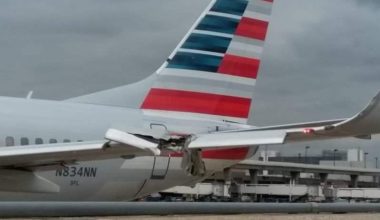Boeing 787 aircraft or Boeing 787 Dreamliner is an iconic long-range jet popular for its superior efficiency, comfortable cabins, state of the art aerodynamic materials. Launched officially at the 2013 Paris Air Show, this dream aircraft of aerospace giant Boeing Company has dramatically improved the air travel experience with industry-leading technology that has led to the airplane’s unparalleled fuel efficiency and range flexibility.
The laps of luxury, comfy cabins, state of the art windows are not the only reasons behind the popularity of this aircraft. Boeing 787 aircraft has been plagued with several issues multiple times that have caused Boeing’s 787 programs to receive several setbacks.

A short description of Boeing 787 aircraft
Boeing 787 Dreamliner aircraft is the most popular variant that has its airframe made of composite materials and utilizes electrical systems extensively. Boeing’s 787 aircraft was designed to shape the future of commercial aviation that required tremendous strides in manufacturing the aircraft. The brand-new class of flying machine is a refinement of flying style for customers as it seeks to consume fuel 20% less on a per-passenger basis than predecessor aircraft.
Boeing 787 has built on a legacy with the latest technology, advanced market, and robust and sophisticated computational tools. It can carry 200 to 300 passengers at a time cruising at the speed of 903 km/hr up to 7,635 nm. The differentiating factor of the 787 flight system from other traditional airliners is an electrical architecture that allows increased thrust and improved fuel efficiency for the aircraft. Another notable feature of the Boeing 787 Dreamliner is the wing ice protection system that is adorned with electrical-thermal heater mats on the wing slat.
Present Scenario
Boeing does best to see through the current crisis where most airlines aren’t making money or making good margins on every flight. The airline industry is in a state of turmoil, proven by the bleak picture painted by financial reports. The marmite aircraft Boeing 787 is no stranger to manufacturing flaws. It continues to struggle from them. The manufacturing quality issue near the nose on certain Dreamliners discovered in July this year prolonged the current 787 delivery halt and forced Boeing to cut the already slow production rate lower than 5 per month. Backlog of about 100 parked, undelivered yet completed aircraft required inspection, rework, extending the duration of large inventory buildup. Though the issue didn’t pose an immediate safety threat, modifications and inspections were required to be conducted before deliveries were resumed.

The negative impacts resulted by new 787 Dreamliner manufacturing flaws:
- Boeing had to pass through tumultuous times and battles to return the problematic 737 Max aircraft. Adding to the sorrow, the large unacceptable gaps around the forwarding pressure bulkhead compelled Boeing to take off 787 productions to identify additional rework.
- The pandemic’s impact on the production of aircraft was enough for Boeing to plunge into cash debt. Thwarting its effort to make money with 787, Boeing Company had to halt 787 Dreamliner delivery until at least late October this year.
- Lack of interest from airlines as halt lingers another serious issue for the aerospace giant. On the one hand, the continued steep drop-off in international air travel has kept airlines in turmoil, while on the other hand, delayed deliveries cause customers to walk away from deliveries.
- The new problem complicated already plagued the 787 programs with unfulfilled aircraft orders.
Boeing couldn’t deliver one aircraft for months due to its resumption only in March 2021. The COVID-19 induced border restrictions, problems with fit, and substantial backlog have all been thorns in piercing 787 Dreamliner aircraft. The nagging problems may seem never-ending on the side of planemaker Boeing. Only in April, the manufacturer was working hard to deliver the majority of 100 aircraft in its inventory before 2022.
Following quality issues discovered in July 2021, Boeing is conducting several months of engineering analysis and inspection work to restore the confidence of its customers and ensure to resume 787 deliveries meeting all regulatory requirements and the highest quality standards.
Boeing 787 production issues
Boeing had suspended the 787 Dreamliner since October 2020 due to various issues raised regarding vertical stabilizer or tail fin. It was the fourth new problem uncovered with Boeing’s popular widebody 787 aircraft. A small depression found at the stop where the tail joins the fuselage led to scrutinizing huge swathes of Dreamliner fleet. The small gap became a big problem for Boeing that raised additional concerns with these young aircraft. While Boeing was keen to downplay the safety concern regarding vertical stabilizers, the issue affected almost 700 of the global Dreamliner fleet.
Previously, eight 787 Dreamliners were grounded over structural issues that aircraft couldn’t meet limit load requirements.

Once the pinnacle of a clean sheet, Boeing Company received several criticisms over 787 issues. March 2021 ended the 5-month drought of 787 Dreamliner delivery, handing over factory-fresh 787-9 to United Airlines. While the fourth production problem related to quality control was still ringing on the planemaker’s ears, the new problem near the 787 Dreamliners discovered in July delayed 100 undelivered 787’s in inventory worth more than 25 billion.
The headache of Boeing is increased as new 787 Dreamliners will likely be paused for deliveries until at least late October. Meanwhile, Boeing 787 customers can redo orders or negotiate for concessions as deliveries linger.
Future of Boeing 787 aircraft
Since the protracted birth of 787 aircraft, the twin-aisle Dreamliner has been dogged by a spate of inspection, rework, and manufacturing quality issues. The marmite 787 is phenomenally an expensive airplane that has encompassed a lot of advanced features. Despite a sharp drop in production weighed down by inspection, or halted deliveries, fuselage issues, and withered demand due to pandemic’s toll on international travel, Boeing’s flagship program still shows a bright future for the jets. The enormous cost of producing the aircraft can be balanced in the future by the sustainable rewards offered by the aircraft.
The long-term perks of flying 787 aircraft are provided by its designs that constitute superior technology, state of the art flight deck, more electrical architecture, smarter systems, smooth wing technology, more revenue cargo, gold care, long-range capability, lower maintenance costs, high speed, value made standard, and commonality savings, etc.
Few features that recognize the advantages of 787 aircraft are:
- Improved cabin air
The state of art filtration system provides better air pressure and humidity so that passengers won’t be fatigued or dry on long-haul flights.
- Higher revenue for airline customers
More cargo volume, more flying days, and range for more frequencies and new direct routes imply high revenue for the airline that flies this iconic aircraft.
- Low cost
The strong and durable composites contribute to 30% less maintenance cost and 15% lower operating costs along with low emission and noise fees.
- High speed
The flexible twin-aisle offerings of aircraft can travel at Mach 0.85, connecting people to different parts of the world in a short duration of time.
- Extended flying life
Robust design and sophisticated composites assure the extended flying life of 787 aircraft. More time in the sky will bring more revenue to the airlines.
787 Dreamliners currently fly to more than 1900 routes, building its worldwide presence and network performance. Lavish interior, elegant windows, spacious cabin tarnishes the fatigue of passengers to perfect long-haul flights, which is also called the Dreamliner effect. The 787 aircraft has revolutionized the way people travel as it is decorated with such features that make air travel safe, comfortable, and joyful. Less use of the hydraulic system, fresh air from outside, dimmable windows, laminar flow control surface, head-up display are the qualities that set it apart from others and add to the joy of air travel.

Boeing 787 aircraft has an excellent future in terms of sustainability as it applies breakthrough technology to obtain fuel efficiency and offset carbon emission and noise. The host of technological improvements reflects the broader aviation picture. The hub buster 787 aircraft has a huge potential to battle for the future of the skies.
Some issues have slashed Boeing’s output, but Boeing is a leader to rule global aviation. Long-haul travel is rebounding slowly, and 787 is poised to grow on new routes and surpass the pre-pandemic level. The upcoming journey is going to be tough for Boeing’s flagship program.
Boeing’s 787 Dreamliner production and supply chain has been a disaster, yet one can predict that Boeing Company will surely take a cost-effective, qualitative step to bring 787 back to where it belongs-above the clouds where it will set the standard of revolutionary design for plane makers to follow in future. Boeing’s 787 aircraft began with a hope and vision, is now culminating in several issues and sorrows, but can turn in victory in the future. Boeing is currently analyzing the aviation scenario worldwide by coordinating with suppliers constantly and aligning demand-supply forces. With an estimated rate of 10 Dreamliner production a month by the end of 2025, Boeing 787 still has a long future ahead of it.








